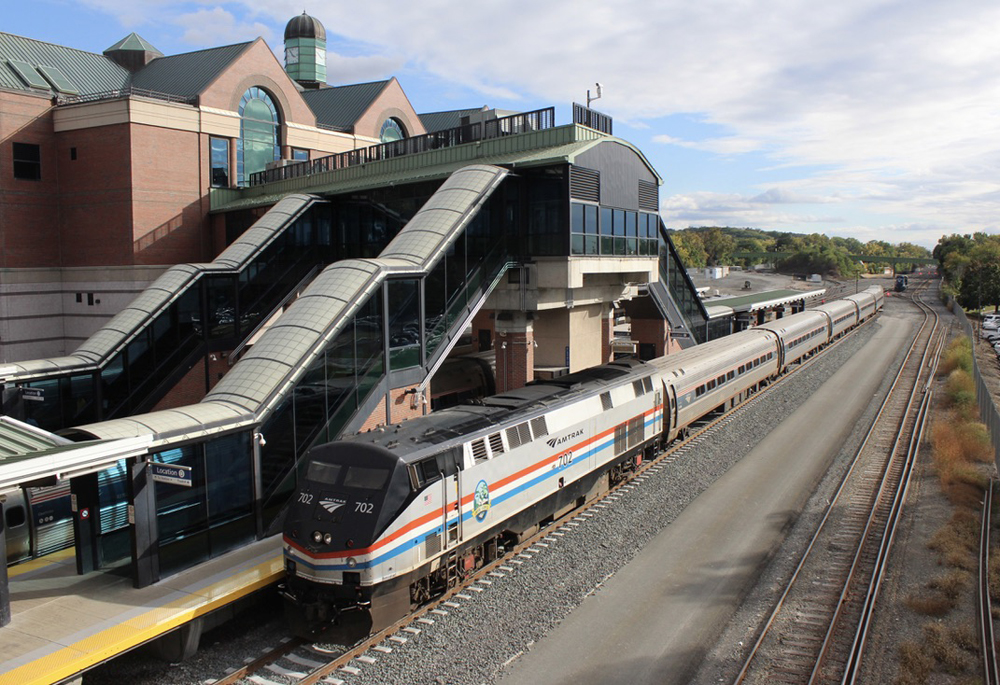
WASHINGTON — While the federal government gathers input on a proposal to allow liquefied natural gas to be moved in tank cars, one company has gotten a special permit to do just that.
On Dec. 5, the Pipeline and Hazardous Materials Safety Administration granted a special permit to Energy Transport Solutions LLC to move LNG in DOT-113 tank cars from Wyalusing, Pa., and Gibbstown, N.J. The announcement comes as PHMSA and the Federal Railroad Administration are seeking public comment on a proposal that would allow the movement of LNG by rail across the country [See: “DOT advances proposal to allow movement of liquefied natural gas in tank cars,” Trains News Wire, Oct. 21, 2019].
One lawmaker — Rep. Peter DeFazio (D-Ore.), chair of the House Committee on Transportation and Infrastructure — was quick to blast the PHMSA for issuing the permit “despite repeated objections from members of Congress and safety and environmental groups,” according to a press release.
“This reckless move by the Administration puts communities in harm’s way,” DeFazio says. “For months I have been sounding the alarm on this dangerous plan. Not only has PHMSA failed to take the proper steps of testing, analyzing or reviewing this unprecedented plan, it failed to provide Congress and the public the opportunity to consider whether the permit’s operating conditions sufficiently address the potential safety implications — an opportunity that’s required by law.”
In June, the House of Representatives passed an amendment trying to prohibit the U.S. Department of Transportation from issuing permits to move LNG by rail. The amendment was in response to an executive order that directed the Secretary of Transportation to finalize a rule within 13 months that would “treat LNG the same as other cryogenic liquids and permit LNG to be transported in approved rail cars.”
In October, PHMSA and FRA began to seek public comment on the proposal to move LNG in DOT-113 tank cars. Liquified natural gas can currently move by truck, or by rail only in a portable tank, with approval by the FRA. The public has until Dec. 23 to submit comments.
In a statement to Trains News Wire, a representative for PHMSA defended the agency’s decision to issue a special permit, noting that it had followed all the rules in doing so. According to federal officials, Energy Transport Solutions had applied for the permit in August 2017 and since then PHMSA has reviewed thousands of public comments. The representative says the shipments are expected to begin in the next six to 12 months. Before the shipments can begin, first responders along the route must be trained for how to handle an incident involving LNG.
“PHMSA issues special permits which allow variances from existing hazardous materials regulations while maintaining an equivalent level of safety,” the representative says.














Looking at a map, Wyalusing may be a collection point of fracked gas production. Gibbstown, NJ may be the site of a terminal for LNG for export. No other move makes economic sense. LNG is moved principally where you can’t build a pipeline – like across an ocean. There may be some spot moves in the US where natural gas pipeline capacity is insufficient for awhile, like when a large coal-fired electric generator switches to natural gas. I haven’t heard of any that would do so before a natural gas pipeline was built out for it. I can’t imagine LNG moving by pipeline. It is always piped as gas at ambient temperature under varying pressure.
Anyway, “fracking”, “flammable material shipment by rail”, “export fossil fuels”; a bigger picture might show there are many related issues dear to environmentalists, and I agree with them within reason. On the other side, Energy Transport Solutions is principally a niche market trucking company. They must think there is money to be made. It might be interesting to follow the money.
The article raises more questions than it answers. The only thing I wish it had was a little more detail on the proposed moves, which I think would be available in the application for exemption. As for a rule to replace the exemption, there are issues not mentioned previously, like what to do about boil-off en route. Can it be captured and compressed into bottles, for instance? Even after stripping away politices, there are a lot of technical issues.
Occasionally, things still get done in this country “despite repeated objections from members of Congress and safety and environmental groups,”
In my humble opinion, it would be a better idea to ship by rail. It is a much more controlled environment then by truck on the highway.
It may be th at we will need to study the container used. Then develop better containers.
As I said in my opinion. As I’ve often said I’m no great expert, just a worn out truck driver. And one who has seen all too many different ways people drive their automobiles on our highways.
No, I am not confusing LNG with anything else. LNG must be kept super cold ( – 260f) or it violently boils off back into a gaseous state. This violent boiling instantly creates a vapor cloud and when that cloud finds the slightest spark there is a blevan or giant explosion. Impossible to imagine what a disaster a unit train full of this would create in a wreck. It should only go by proper pipeline no other way.
IMHO-Ross Rowland
Ross…. You are confusing LNG with LPG, and Mr. DeFazio is the current problem with Gov’t today. Lack of intellect on his part to be honest with the public. Instead he cries foul based on his own ignorance of gases and their properties.. Just remember this.. People actually voted for this person..
Ross, A question for you. How do YOU think we should ship propane, butane or methane? There are companies selling wood-fired furnaces or pellet stoves. Are you going to outlaw them? As it gets cold this winter and the storms come off the Pacific, let’s cut off the power to DeFazio’s office & his mansion! It i impossible to build pipelines to every location that uses LNG!
What puzzles me is the willingness to ship the stuff by truck, but not by rail. Just weird. I suppose it is a matter of visibility — trucks are largely invisible to the general public (just ask any semi driver) but trains aren’t.
Mr Roland I belong to a local Fire Dept. We have had drills on LNG an LPG for one thing LNG is lighter than air and will rise where on the other hand LPG is heavier than air and will lay low to the ground an when it as you say boils of to a gaseous state being close to the ground it’s very easy to find a ignition point. An seeing that they are all ready hauling LPG I don’t see much of a difference An as you say LNG must be kept cold (-260f) your not going to put that in a pipe line. An if you don’t think propane is cold look at your 20 lb grill tank when your using a lot of the gas. It will form frost at it’s liquid level.
We’ve had at least one pretty serious LNG truck accident since I’ve lived in Alaska. We’ve had multiple fuel truck accidents, some with fires, many with spills, and a couple, tragically, with fatalities. In that time, a single derailment of a tanker car without spill or fire on an Alaskan Railroad train. You’ll have to show me pretty compelling numbers to convince me that truck is a safer way to transport LNG than train.
By the way, Alaska Railroad did have a permit to carry LNG in a container on a trial basis.
We use LNG in Fairbanks, but all comes by truck over 350 miles (!) from Anchorage area.
Don’t see the problem with moving either LPG or LNG by rail, myself, but what the bleep do I know?
The above comments are genetic in nature and do not form the basis for an attorney/client relationship. They do not constitute legal advice. I am not your attorney. Thank you for your latest sex toys order. You have selected the large red vibrator as shown on our display wall. Please select another item. That item is our fire extinguisher.
Gerald McFarlane
Advocating violence has no place in this forum.
What’s a “blevan”? Maybe the intended term is “bleve” – “boiling liquid expanding vapor explosion”. LNG can be safely transported in tank cars (not “tanker cars”).
If you think LNG is safe then google lng accidents and view the video of what happened when an 18 wheeler carrylng lng jack knifed, ruptured the lng tank, the lng poured out onto the roadway, formed a giant vapor cloud as it boiled off into a gas and when that cloud found a spark there was a MASSIVE explosion that incinerated everything within 400 yards.
Hard to imagine the magnitude of what could happen with a unit train of lng in a wreck. Should it happen in or near a population center it would be beyond horrible !!!
Mr. DeFazio is 100% right. LNG should NEVER be shipped by rail or truck.
IMHO-Ross Rowland
Someone needs to school DeFazio on just how safe LNG is, the man needs to have some sense knocked into him.
Would those who are objecting prefer to see the LNG move by truck, or are they totally opposed to moving it at all? I would not be surprised if the latter be true; anti-fossil fuel types.
How is this different (risk wise) than shipping anhydrous ammonia or cryogenic nitrogen?
Europe is testing light rail cars powered by fuel cells using compressed hydrogen.
Cryogenic Hydrogen (LH2) still requires a framed bottle using half container sizes.
Linde Group sends hazmat chems by rail all the time.
I agree testing is good and results from the permit should be looked over.
But DeFazio is speaking more to his constituents unfortunately.